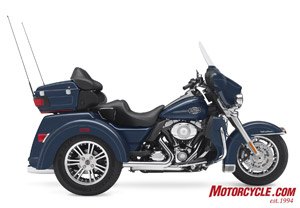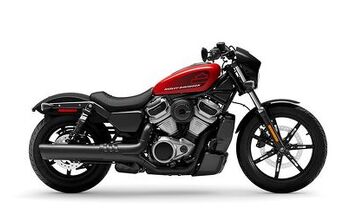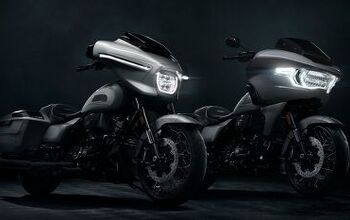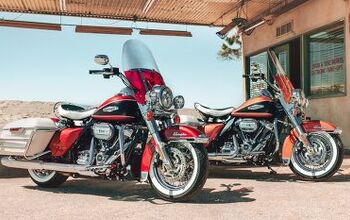2009 Harley-Davidson Touring Models Review - Motorcycle.com
The big news coming out of Milwaukee for 2009 is an all-new chassis for the touring bikes in Harley’s line-up. We sampled the new frame during our time at the 2009 CVO launch on a couple of the touring bikes a few weeks ago. Now we take an even more in-depth look at this new chassis found on all seven bikes in Harley’s touring line. We also ride the latest low-slung machine to join the V-Rod family, and get a peek at some of the updates to the rest of the 2009 Harley-Davidson models.
At the CVO models unveiling just a couple of weeks ago the Motor Company gave us the info that touring models will now have an all-new two-piece frame that is welded together robotically. An added bonus, in addition to much improved handling, was an increase in gross vehicle weight rating (up by 100 lbs).
After 28 years of using the same basic frame architecture, Harley decided it was time to debut a new chassis to continue their dominance of the touring segment. “This was the biggest undertaking since the creation of the platform,” said Ben Wright, 2009 Touring Project Lead and Platform Staff Engineer.
The project started as far back as ’02 with preliminary research, then really got boiling when Harley conducted face-to-face interviews with attendees that collectively rode millions of miles to H-D’s 100th anniversary in 2003.
Harley staff would interact with customers at various shows and events, going so far as to have riders weigh their loaded touring sleds on a scale to see how much the touring bikes were carrying. According to Wright it wasn’t unusual to have a customer avoid the scales out of fear of how far past GVWR they had gone. It was becoming clear to Harley that a more robust frame was needed.
No longer just a collection of hand-welded steel tubes, the new frame – and what is commonly referred to on most other motorcycles as the subframe – is now made from various investment cast, forged and stamped pieces. An unforeseen advantage to having the tail (sub) frame bolt on is the lessening of the likelihood that a whole bike will be totaled by insurance companies.
'It was becoming clear to Harley that a more robust frame was needed'
Wright informed us that only recently a test unit or two were able to be snatched from the clutches of total waste, as the tail frame could simply be unbolted and replaced with a new piece, putting the bike back in action. And in a victory for new tech, total frame parts count has been reduced to 40 pieces versus the 90 bits that made up the previous frame. Without going into specifics, Harley engineering staff touted increased torsional stiffness but not necessarily increased lateral rigidity.
Carrying the Twin Cam 96 V-Twin powerplant in the new frame are new vibe-isolating engine mounts. Ditching the tri-mount system on the old chassis, the new system now uses two mounts in front instead of one. “This gives us a lot of control of the powertrain within the frame, helps us reduce sidle shake and is another key element in the tooling of the chassis,” explained Wright.
New dimensions include moderately increased trail and a 0.5-inch growth of the wheelbase gained in the new swingarm that’s now wider and stiffer than the previous swinger. New triple clamps hold a front suspension re-tuned for improved ride quality; the air-suspended shocks also have been recalibrated for better handling and comfort.
Keeping the new frame rolling smooth is a 17-inch wheel up front that is increased from 16 inches – Road King Classic retains a 16-inch front hoop. The rear wheel is still a 16 on all bikes but is now 5 inches wide, and the “rear compensator” (read: cush drive) is now integrated into the hub rather than being a bolt-on application and carries a 68-tooth sprocket, up 2 teeth from last year. Five of the seven touring models also get new, bombproof-looking 28-spoke cast-aluminum wheels.
Dunlop went to great lengths to craft a new multi-compound tire specifically for the FL platform. The 180/65-16 D407 Multi-Tread rear tire (found on all bikes) has tread life reportedly increased 27% thanks to the harder center compound developed with the bike’s higher load capacity in mind, while the softer side compound allows riders to confidently access the new chassis’ increased lean angle.
Form follows function, as the saying goes, and in this instance a wider rear fender sporting a simplified and lower license plate assembly with LED lighting (on FLHR, FLGT, FLHX and FLTR models only) covers the widened rear wheel/tire. An increased load capacity of 5 pounds in each of the saddle bags and the Tour Pak on models so equipped comes courtesy of new support racks for said saddle bags and Pak.
Finally, though nothing has fundamentally changed with the engine, a re-routed left-side exhaust header pipe now snakes under the bike for improved rider comfort via a reduction in exhaust heat. The head pipes are now a single-piece construction and thereby eliminate unnecessary welds that can, over time, be weak spots for potential exhaust leaks.
Further protecting rider and passenger from the miserable heat wafting up from the engine is what Harley calls its Rear Cylinder Cut-Out system. EITMS (Engine Idle Temperature Management System) will calculate a myriad of data and determine when to stop fueling to the rear cylinder with the net affect being a cooler engine when you’re jammed up and sitting idly in rush hour traffic. This system, known colloquially as “parade mode” was previously available as a mid-year 2008 retro-fit to address TC96 heat issues on FLs.
For 2009, all FL (touring) models will now allow this feature to be rider activated. In simple terms, when at a stop with the engine idling, the rider can roll the twistgrip forward for a duration of 5 seconds at which time the cruise control activation light will indicate that RARCC (Rider-Activated Rear Cylinder Cut-Out) has been de-activated or activated.
Phew! Whole lotta changes happening to the basic elements of the touring bikes.
After sidling up to an attractive blue and silver two-tone Ultra Classic Electra Glide in order to enjoy the pastoral beauty of grape-a-licious Sonoma County, CA, I can happily report that all of the effort put into the new touring frame was worth it. Gone is the disconcerting “seeking” feeling the front-end on previous rigs would exhibit when rolling the superslab.
Wonderfully absent too is the eye-popping hinge-in-the-middle-of-the-frame sensation many of the top-heavy touring beasts gave when trying to maneuver at slower speeds and in tight, parking-lot-like environs. Bending the big bike through fast-paced sweepers revealed a distinct lack of flex and wallow commonly experienced on the previous chassis.
Yes, this new, beefy two-piece kit is a boon for the FL platform. The only thing we’re left to do is badger the Milwaukee-based bike maker with the question, “Why’d ya wait so long? (sniff sniff)”
New 2009 Harley-Davidson Tri Glide Ultra Classic trike
In case anyone was wondering, this Ultra Classic-based trike isn’t a kit trike, but the real deal from Harley. The great thing, according to H-D staff, about the new touring frame is that it allows flexibility in various uses. Case in point is the Tri Glide. The frame has been strengthened for the additional weight inherent in a trike, and a steering damper was added. Otherwise, it has “all the features of an Ultra Classic,” according to Jim Hofmann, Director of Core Motorcycle Product Planning.
This bike isn’t a servicar reborn but a whole new unit. It sports triple clamps unique to the Tri Glide and more relaxed steering geometry. Additionally, the large box at the rear has 4.3 cubic-feet of storage with a weight capacity of 50 lbs. Both rear fenders can be removed independent of the rest of the bodywork in the event of a bang up, and the fender brake lights also function as turn signals.
The 2009 Tri Glide Ultra Classic retails for $29,999. The electric reverse option is available for an additional $1,195.
2009 Softail Heritage Classic is even classier
Heritage is in its name, and rightfully so as this timeless beaut is always in style. For ’09 this bike gained a wider passenger seat and backrest, new seat and saddlebag trim, half-moon floorboards and oval brake pedal courtesy the new CrossBones, and it also got a taller handlebar.
Other styling updates include new tank graphics accented by a glass-filled cloisonné, retro speedo and Cat-Eye fuel tank console, new front fender trim inspired by the HydraGlide, a new chrome nacelle and a factory option of wide whitewall tires matched to chrome aluminum laced wheels.
Related Reading
2009 Harley-Davidson CVO Models Review
2009 Harley-Davidson Model Line-up
2009 Harley-Davidson Tri Glide Ultra Classic
2008 Harley-Davidson Models
All Harley-Davidson on Motorcycle.com
More by Pete Brissette




































Comments
Join the conversation